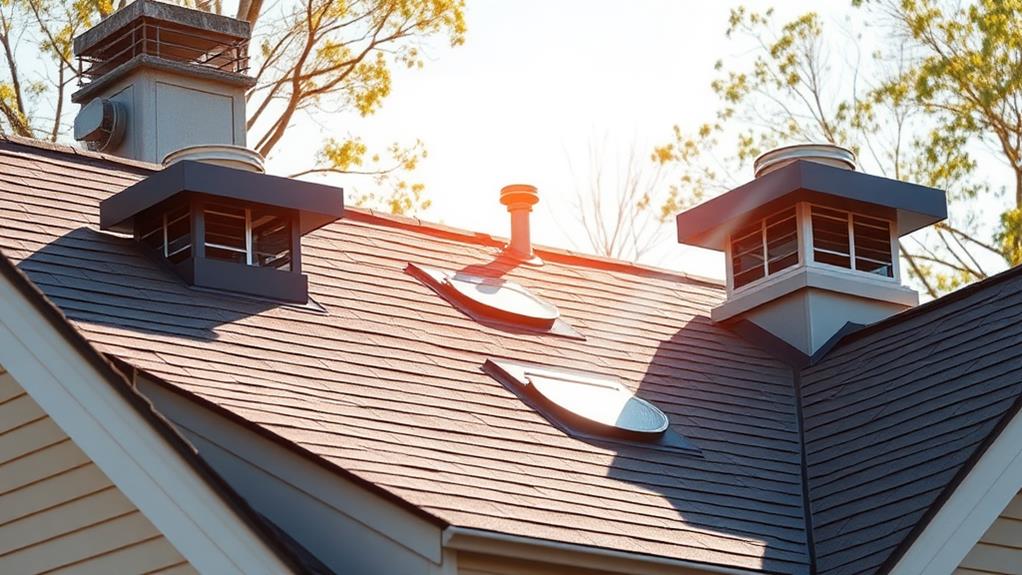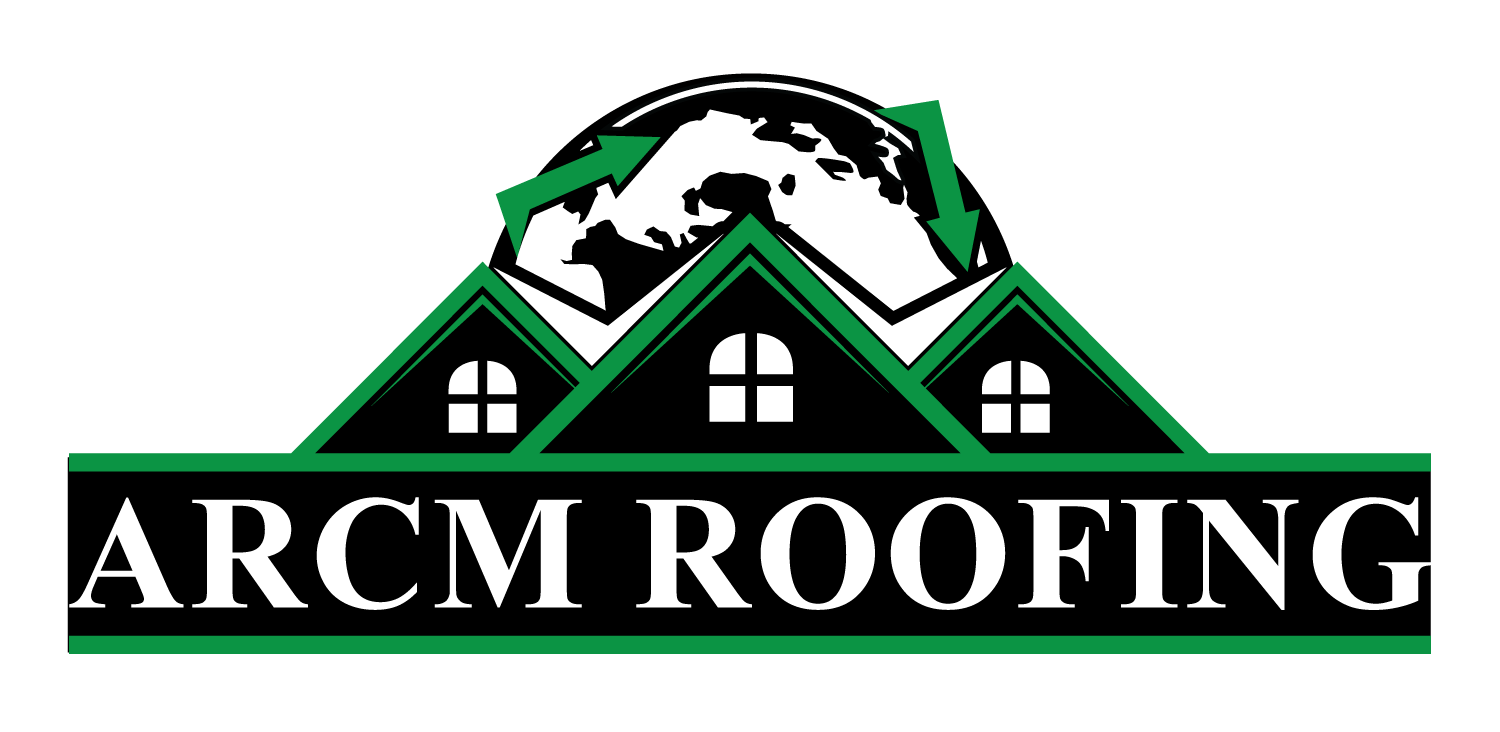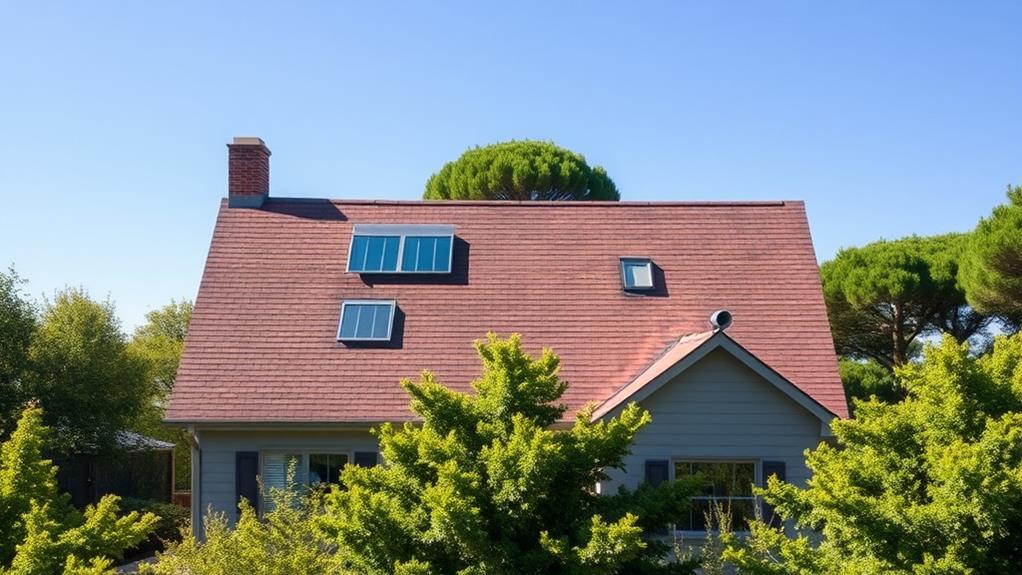Roof ventilation plays a pivotal role in ensuring a home's energy efficiency, structural integrity, and indoor air quality by facilitating proper airflow and moisture control. Various ventilation systems such as ridge vents, soffit vents, gable vents, and attic fans cater to different architectural needs and climates. Their integration is essential for regulating temperature extremes, preventing moisture-induced damages, and optimizing energy usage, consequently lowering heating and cooling costs. By tailoring ventilation installations to specific home designs, homeowners enhance comfort while safeguarding against mold and structural vulnerabilities. Understanding these elements reveals how roof ventilation fosters a sustainable, resilient living environment.
Roofing Highlights
- Roof ventilation regulates temperature and prevents moisture buildup, ensuring energy efficiency and comfort.
- Types of roof ventilation include ridge vents, soffit vents, gable vents, and attic fans.
- Effective ventilation maintains indoor air quality, reducing risks of mold and structural damage.
- Properly installed vents enhance airflow, promote sustainability, and reduce heating/cooling costs.
- Expert assessment tailors ventilation systems to suit specific architectural and environmental needs.
Roof Ventilation Basics

Understanding the basics of roof ventilation is pivotal for maintaining a balanced and energy-efficient home environment, as proper airflow prevents moisture buildup and prolongs the lifespan of roofing materials.
Several types of ventilation systems, including ridge vents, soffit vents, and attic fans, each serve unique functions to optimize this airflow. For homes in regions with harsh weather conditions, like those served by ARCM Roofing, choosing appropriate materials is also vital for adequate protection.
When considering installation methods, it is crucial to evaluate the specific needs of the home to guarantee a system that integrates seamlessly while functioning effectively to promote air circulation.
Importance of Airflow
Effective roof ventilation is a critical component in maintaining a home's structural integrity and energy efficiency. Proper airflow is essential in safeguarding the roof against the detrimental effects of heat and moisture accumulation. When airflow is managed efficiently through targeted ventilation, it helps regulate temperature extremes, thwarting the formation of ice dams during winter and reducing attic heat gain in summer. Such regulation not only preserves the roofing materials, prohibiting premature wear and tear but also optimizes the home's energy consumption, leading to potential cost savings on heating and cooling.
Emphasizing airflow's importance also intersects with issues of indoor air quality. Insufficient ventilation can lead to a buildup of excess moisture, which fosters mold and mildew growth, compromising the air homeowners breathe. This impact extends beyond comfort, touching on health and well-being, ensuring that residents experience a sense of belonging in their living space. By enhancing airflow through strategic roof ventilation, homeowners can achieve a balanced environment within their home's microclimate.
Ultimately, understanding and implementing effective airflow strategies is integral to conserving the structural longevity and efficiency of a residence, creating an encompassing sense of safety and comfort for those who dwell within.
Types of Ventilation
There are several types of roof ventilation systems that play a pivotal role in ensuring ideal airflow throughout a home. Effective roof ventilation is not merely a matter of comfort; it maintains the structural integrity of a building while fostering a sense of unity within the household by mitigating temperature disparities.
Among the different systems, one finds ridge vents, which run along the peak of the roof and permit warm air to escape naturally, harmoniously drawing in cooler external air. This creates a continuous cycle, ensuring even distribution of temperatures.
Another prevalent approach is the installation of gable vents. Positioned at the ends of the attic, these vents facilitate cross-ventilation, counteracting moisture accumulation and instilling a sense of security in the space beneath. Soffit vents, located under the eaves, work inclusively with other systems by allowing fresh air to enter the attic from below, creating a balanced airflow.
Common Installation Methods
To properly install a roof ventilation system, precise methods need to be followed to optimize airflow and guarantee structural efficacy. The most frequently employed method is the ridge and soffit installation technique, which creates a natural flow of air by allowing hot air to rise and escape through the ridge vents while cooler air enters from the soffits. This method capitalizes on passive ventilation, offering homeowners a balanced system that harmonizes with the natural laws of thermal dynamics to maintain an optimum climate within the home.
Another common approach is the gable vent installation. This involves placing vents at the gable ends of a home, typically near the peak of the roof. Gable vents are highly effective in homes with attic spaces as they enable cross ventilation, promoting the free movement of air which can considerably alleviate heat buildup and moisture accumulation.
Further options include the installation of powered vents, such as attic fans, which actively expel hot air through electrical or solar energy. These are particularly beneficial in climates with extreme heat, offering an efficient solution for rapidly ventilating a space and preserving the home's structural integrity. Together, these methods provide varied solutions tailored to distinct architectural and environmental needs.
Benefits

Roof ventilation offers significant advantages, primarily through enhancing air circulation, which helps maintain consistent indoor temperatures and supports overall home comfort. By improving ventilation, homeowners can also achieve notable energy efficiency gains, as it assists in reducing the workload on heating and cooling systems, thereby leading to potential cost savings on energy bills.
Residential roofing products are designed for steep slope applications and can additionally optimize this ventilation, making them an ideal choice for ensuring a long-lasting impact. In addition, a well-ventilated roof is indispensable in diminishing the risks associated with mold and moisture accumulation, ultimately safeguarding the structural integrity of the home and contributing to a healthier living environment.
Improved Air Circulation
Effective air circulation is a cornerstone of a healthy and efficient home environment, bringing a multitude of benefits that extend beyond mere comfort. By fostering a consistent airflow, roof ventilation remarkably enhances indoor air quality, contributing to the overall well-being of the household. This circulation helps expel accumulated heat, moisture, and pollutants from the home, consequently reducing the potential for mold growth and maintaining a fresh and breathable atmosphere.
Furthermore, improved air circulation through proper roof ventilation can play a critical role in preserving the structural integrity of a house. Over time, excessive moisture accumulation can weaken roofing materials and other structural components, leading to costly repairs and undermining the safety and longevity of the house. By ensuring the efficient expulsion of humidity, roof ventilation safeguards against these risks.
Additionally, it fosters a stable indoor environment, promoting thermal comfort during seasonal changes. This stability not only enhances the comfort of a home but also supports a sense of belonging within the community of homeowners who prioritize the health and safety of their living spaces. Therefore, effective roof ventilation is not merely a technical feature but an essential component in cultivating an inviting and resilient home.
Energy Efficiency Gains
Beyond enhancing indoor air quality and structural integrity, optimized roof ventilation greatly impacts a home's energy efficiency. By facilitating the natural flow of air and balancing internal temperatures, proper roof ventilation minimizes reliance on mechanical heating and cooling systems. During warmer months, heat accumulation within the attic can dramatically raise indoor temperatures, compelling air conditioning units to expend additional energy to maintain comfort. A well-ventilated roof dissipates excess heat, reducing the strain on air conditioners and, as a result, lowering energy consumption. This thoughtful design not only supports the cooling systems but can also extend their operational lifespan, fostering sustainable home management practices.
In winter, adequate roof ventilation helps to prevent the buildup of excessive moisture and stagnant air, both of which can also impact thermal regulation. When insulation stays dry and efficient, heating systems do not need to work overtime to compensate for heat loss, consequently promoting energy conservation. For homeowners, these energy efficiency gains contribute to reduced utility bills, fostering a sense of financial stability and responsible resource management. Roof ventilation emerges as an integral element in the holistic approach to energy conservation, ensuring a home environment that is both comfortable and economically sustainable.
Mold and Moisture Reduction
One pivotal benefit of adequate roof ventilation is its role in reducing mold and moisture accumulation within the home. Mold thrives in environments where moisture is unchecked, which can often occur in inadequately ventilated spaces like attics and roof structures. Proper ventilation helps in circulating air effectively, expelling excess moisture that can arise from commonplace activities such as cooking, showering, and even breathing. By consistently removing this moist air, roof ventilation plays a critical part in maintaining a dry and healthy home environment, indispensable for preventing mold proliferation.
Mold not only compromises the structural integrity of your abode by deteriorating building materials but also poses significant health risks to its inhabitants. In particular, mold can exacerbate conditions such as asthma and cause allergic reactions, threatening the well-being of the household. As a result, having a well-ventilated roof becomes a linchpin in safeguarding both your home and your family's health.
For communities that value safe and sustainable living environments, roof ventilation acts as a steadfast guardian, ensuring that homes remain free from the detriments of mold and moisture—a simple yet effective measure that fosters peace of mind and community well-being.
Energy Efficiency Improvements

Optimizing roof ventilation can considerably contribute to the energy efficiency of a home by mitigating excessive cooling costs and fostering enhanced air circulation, which collectively work to minimize heat accumulation within the attic space. By curbing the reliance on air conditioning systems through effective ventilation strategies, homeowners can witness a noticeable reduction in energy bills while promoting a more comfortable living environment. Consider the components outlined below that play a pivotal role in this energy-saving approach:
| Component | Benefit |
|---|---|
| Ventilation Systems | Reduced Cooling Costs |
| Airflow Optimization | Enhanced Air Circulation |
| Thermal Regulation | Minimized Heat Accumulation |
| Energy Savings | Lower Utility Bills |
Reduced Cooling Costs
Efficient roof ventilation stands as a pivotal element in reducing cooling costs and enhancing energy efficiency in homes. By allowing trapped heat to escape, proper ventilation mitigates the load on air conditioning systems, which otherwise work tirelessly to maintain comfortable indoor temperatures. This not only reduces the demand for energy consumption but also curtails the monthly utility expenses, fostering both economic and environmental benefits. Over time, the investment in roof ventilation can lead to significant savings, transforming initial costs into long-term economic advantages.
Moreover, roof ventilation plays a critical role in maintaining the longevity and efficacy of your air conditioning system. As systems operate under less strain, their longevity is bolstered, ultimately reducing the need for costly repairs or early replacements. Ventilation systems contribute to the regulation of indoor temperatures by creating a balanced thermal environment, which is essential for both comfort and financial prudence.
For those seeking to belong to a proactive community that values sustainability and cost-effectiveness, enhancing roof ventilation aligns seamlessly with these objectives. Embracing this strategy empowers homeowners to actively participate in reducing their environmental footprint, while simultaneously reaping the economic benefits of improved energy efficiency.
Enhanced Air Circulation
Boosting air circulation through roof ventilation markedly elevates energy efficiency within a home. By facilitating the natural movement of air, roof ventilation systems enhance the indoor environment, promoting a consistent airflow that refreshes living spaces while simultaneously reducing dependency on artificial cooling and heating systems.
This continual exchange of air also expels stagnant indoor air, replacing it with fresh, cooler air from outside, which in turn reduces the load on HVAC systems, thereby prolonging their lifespan and maximizing energy consumption.
Integrating efficient roof ventilation contributes to creating an environment where residents feel a profound sense of belonging. A well-ventilated home not only fosters comfort but also supports well-being by maintaining an exceptional indoor climate throughout the year. This is achieved by strategically installing vents that encourage effective cross-ventilation, ensuring that heat, moisture, and various pollutants are efficiently dissipated.
Moreover, an advanced ventilation system contributes considerably to the eco-friendliness of a household by minimizing the energy required for heating and cooling. This strategic approach to enhancing air circulation aligns with sustainable living practices, empowering homeowners to take an active role in energy conservation while cultivating a harmonious living space.
Minimized Heat Accumulation
In addition to enhancing air circulation, roof ventilation plays a pivotal role in minimizing heat accumulation, which leads to considerable improvements in energy efficiency. By allowing hot air to escape while enabling cooler air to enter, roof ventilation reduces the temperature within attics and roof spaces. This process alleviates the burden on air conditioning systems, diminishing the need for excessive energy consumption during hotter months. Attic temperatures can otherwise rise drastically, transferring heat into living spaces and necessitating more frequent use of cooling appliances. By facilitating this efficient heat exchange, roof ventilation aids in maintaining more consistent and manageable indoor temperatures.
Furthermore, the strategic integration of vents—be it ridge vents, soffit vents, or gable vents—ensures that roof systems can collectively breathe, enhancing their long-term performance. This calibrated airflow contributes not only to a substantial reduction in energy bills but also prolongs the lifespan of roof shingles by preventing heat-induced degradation. Members of environmentally-conscious communities can, as a result, find belonging in adopting these green technologies, as they resonate with the shared objective of reducing environmental footprints. Embracing roof ventilation solutions ultimately reinforces the commitment to sustainable living while fostering both comfort and unity within the community.
Connect With Us
Are you ready to improve the comfort and efficiency of your home with expert roof ventilation solutions? Our team of specialists is here to help you breathe easier.
Contact us today to discuss how we can optimize your home's ventilation. Call us at (303) 306-8384, and let's create a healthier living environment for you and your family!
Roofing FAQ
What Are the Different Types of Roof Ventilation Systems Available?
Various ventilation systems exist, including ridge, soffit, gable, and turbine vents. Each offers unique benefits, enhancing airflow and energy efficiency. Selecting the ideal system fosters improved indoor climate, aligning with communal and environmental aspirations for sustainable living.
How Can I Tell if My Current Roof Ventilation Is Inadequate?
To determine ventilation adequacy, assess indicators such as elevated attic temperatures, uneven heating or cooling within living spaces, moisture buildup, or visible mold. Community forums and local associations provide support, offering shared experiences and recommended solutions for improvement.
Are There DIY Methods to Improve Roof Ventilation?
Improving ventilation may be achieved through DIY methods such as installing soffit vents, ridge vents, or attic fans. Ensuring proper airflow fosters a comfortable environment and a sense of belonging within the structure, enhancing overall satisfaction.
Can Roof Ventilation Affect Indoor Air Quality?
Effective ventilation systems substantially influence indoor air quality by regulating temperature and moisture levels. By reducing pollutants and maintaining balanced air exchange, they cultivate a healthier and more comfortable living environment for residents, fostering community well-being.
How Does Climate Impact the Choice of Roof Ventilation?
Climate markedly influences roof ventilation decisions as varying temperature and humidity levels require tailored solutions. Efficient ventilation systems foster comfort, health, and sustainability, ensuring homes remain safe havens resilient to climatic challenges, reinforcing community wellbeing.




